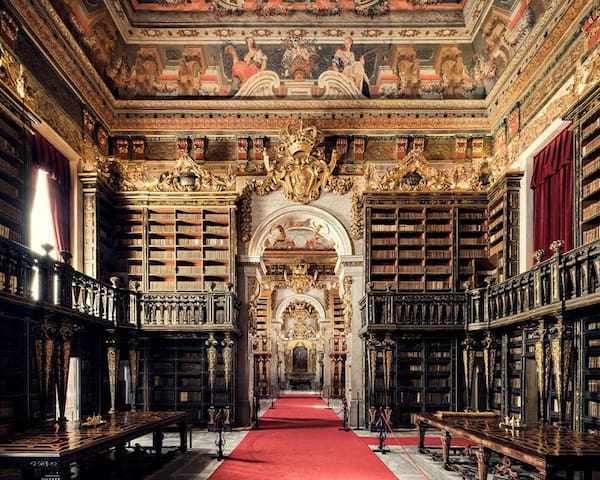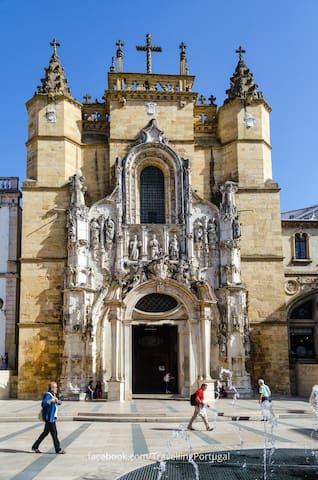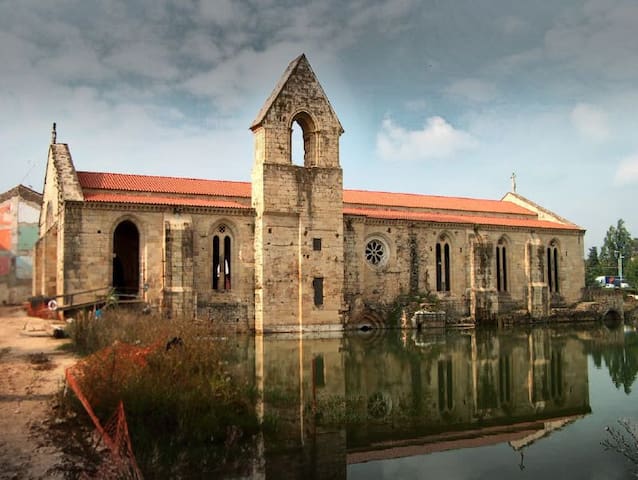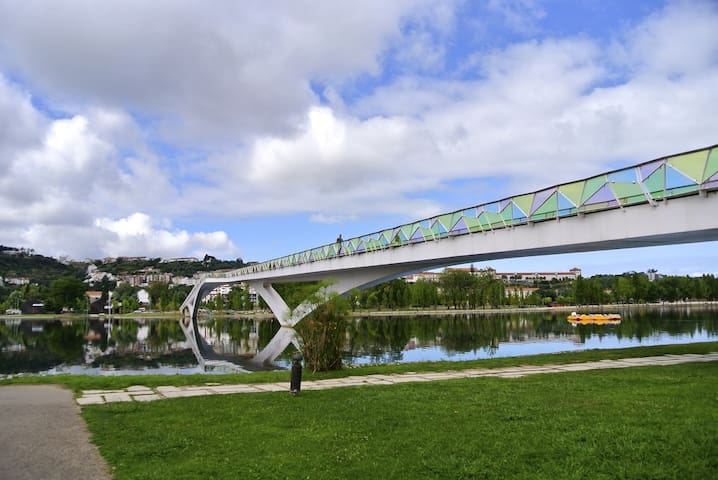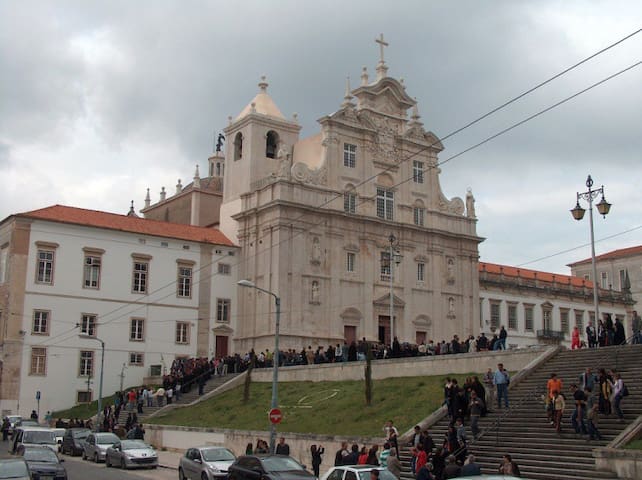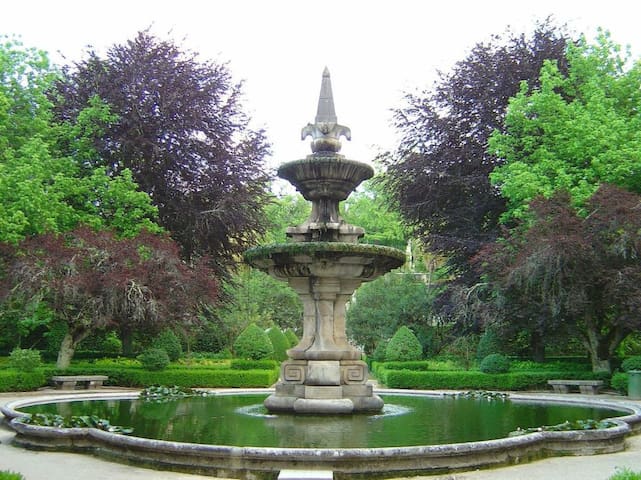Passeio turístico
The oldest university in Portugal is a World Heritage Site, high on a hill in the middle of the city.
It’s a big tourist draw and has hundreds of years of history to show off.
You could scale the 180 steps in the 16th-century tower at the highest point of the university for an awesome perspective of the city.
Also well worth your time is the Sala dos Capelos, the 17th-century ceremonial hall and you need to survey the magnificent ensemble on the Paço das Escolas courtyard.
Unruly students were locked up at the students’ prison, and you’ll begin the whole experience by crossing the Iron Gate, which was once the entrance to Coimbra’s medieval citadel.
(500 meters from this accommodation)
120 persone del luogo consigliano
Università di Coimbra
The oldest university in Portugal is a World Heritage Site, high on a hill in the middle of the city.
It’s a big tourist draw and has hundreds of years of history to show off.
You could scale the 180 steps in the 16th-century tower at the highest point of the university for an awesome perspective of the city.
Also well worth your time is the Sala dos Capelos, the 17th-century ceremonial hall and you need to survey the magnificent ensemble on the Paço das Escolas courtyard.
Unruly students were locked up at the students’ prison, and you’ll begin the whole experience by crossing the Iron Gate, which was once the entrance to Coimbra’s medieval citadel.
(500 meters from this accommodation)
This esteemed Baroque library is on the Paço das Escolas, where Portugal’s earliest kings once lived.
It goes back to the 1720s and needs to be seen to be believed.
The library is composed of three vast salons, bounded by monumental doorways.
Each salon has tall lacquered and gilded shelves, and enormous study tables made with dark hardwood shipped over from Brazil.
There are more than 250,000 volumes here, dating from the 1500s to the 1700s and dealing with history, geography, medicine, law and science.
One of the curious things you’ll learn about the library is that it maintains a colony of bats bred to eat insects that would damage the books.
(500 meters from this accommodation)
51 persone del luogo consigliano
Biblioteca Joanina
This esteemed Baroque library is on the Paço das Escolas, where Portugal’s earliest kings once lived.
It goes back to the 1720s and needs to be seen to be believed.
The library is composed of three vast salons, bounded by monumental doorways.
Each salon has tall lacquered and gilded shelves, and enormous study tables made with dark hardwood shipped over from Brazil.
There are more than 250,000 volumes here, dating from the 1500s to the 1700s and dealing with history, geography, medicine, law and science.
One of the curious things you’ll learn about the library is that it maintains a colony of bats bred to eat insects that would damage the books.
(500 meters from this accommodation)
With a very atmospheric venue Coimbra’s episcopal palace, this fantastic Museum is named for the 18th and 19th-century sculptor, Joaquim Machado de Castro.
The building was constructed in phases from medieval times onwards, and is found at the same site as Coimbra’s Roman forum.
A vestige of this ancient history, the cryptoporticus (covered passageway) is preserved in the lower levels.
The museum’s art has been curated from regional churches and other defunct religious institutions.
You’ll browse the largest collection of sculpture in any Portuguese National Museum, as well as tapestries, ceramic altarpieces and a catalogue of paintings from the 15th to the 19th centuries.
(600 meters from this accommodation)
67 persone del luogo consigliano
Museu Nacional de Machado de Castro
Largo Doutor José RodriguesWith a very atmospheric venue Coimbra’s episcopal palace, this fantastic Museum is named for the 18th and 19th-century sculptor, Joaquim Machado de Castro.
The building was constructed in phases from medieval times onwards, and is found at the same site as Coimbra’s Roman forum.
A vestige of this ancient history, the cryptoporticus (covered passageway) is preserved in the lower levels.
The museum’s art has been curated from regional churches and other defunct religious institutions.
You’ll browse the largest collection of sculpture in any Portuguese National Museum, as well as tapestries, ceramic altarpieces and a catalogue of paintings from the 15th to the 19th centuries.
(600 meters from this accommodation)
Rooted in the earliest years of the Portuguese monarchy, this monastery goes back to the 12th century.
The architecture though is later, with a 16th-century Manueline design summed up by the captivating decoration on the main portal, ceiling and cloister outside.
Later that same century the pulpit and gilded wooden stalls were added in a resplendent Renaissance style.
But the big story at the monastery has to be the tombs of Portugal’s first two kings, Afonso Henriques and Sancho I. They reigned in the 12th century and in the 1500s their remains were transferred to a marvellous Manueline ensemble sculpted by Nicolau Chanterene.
(700 meters from this accommodation)
57 persone del luogo consigliano
Chiesa di San Giacomo
Praça 8 de MaioRooted in the earliest years of the Portuguese monarchy, this monastery goes back to the 12th century.
The architecture though is later, with a 16th-century Manueline design summed up by the captivating decoration on the main portal, ceiling and cloister outside.
Later that same century the pulpit and gilded wooden stalls were added in a resplendent Renaissance style.
But the big story at the monastery has to be the tombs of Portugal’s first two kings, Afonso Henriques and Sancho I. They reigned in the 12th century and in the 1500s their remains were transferred to a marvellous Manueline ensemble sculpted by Nicolau Chanterene.
(700 meters from this accommodation)
Back when Coimbra was a frontier between Christianity and Islam, King Afonso Henriques established this Romanesque cathedral.
It was built not long after his victory over the Moors at the Battle of Ourique in 1139, and unlike other churches of its day has kept a lot of its Romanesque character.
You’ll know that you’re at a boundary between worlds when you approach the austere facade, which is capped with crenellations and has only slender openings in its wall.
Inside, the primitive barrel vault hints at the great age of the cathedral, and the column capitals have wonderful foliate, geometric and bestial designs.
Lovers of medieval art will have 380 of these masterful capitals to inspect!
(450 meters from this accommodation)
45 persone del luogo consigliano
Vecchia cattedrale di Coimbra
Largo da Sé VelhaBack when Coimbra was a frontier between Christianity and Islam, King Afonso Henriques established this Romanesque cathedral.
It was built not long after his victory over the Moors at the Battle of Ourique in 1139, and unlike other churches of its day has kept a lot of its Romanesque character.
You’ll know that you’re at a boundary between worlds when you approach the austere facade, which is capped with crenellations and has only slender openings in its wall.
Inside, the primitive barrel vault hints at the great age of the cathedral, and the column capitals have wonderful foliate, geometric and bestial designs.
Lovers of medieval art will have 380 of these masterful capitals to inspect!
(450 meters from this accommodation)
Yet another monument intertwined with Portuguese medieval history, the Gothic Monastery of Santa Clara-a-Velha has the added mystique of once submerged by the river.
It dates to the 1300s but after the Mondego had flooded over hundreds of years the site was abandoned in the 1600s when the convent’s nuns moved to higher ground and founded the Monastery of Santa Clara-a-Nova.
This site was turned into a proper attraction in the noughties, when an interpretation route and visitor centre were set up.
At the centre you’ll get to see short film about the monastery, including its foundation by the 14th-century Queen Elizabeth.
She is buried at the monastery in an imposing Gothic tomb.
(900 meters from this accommodation)
35 persone del luogo consigliano
Museo del Monastero di Santa Clara-a-Velha
57 R. BaixoYet another monument intertwined with Portuguese medieval history, the Gothic Monastery of Santa Clara-a-Velha has the added mystique of once submerged by the river.
It dates to the 1300s but after the Mondego had flooded over hundreds of years the site was abandoned in the 1600s when the convent’s nuns moved to higher ground and founded the Monastery of Santa Clara-a-Nova.
This site was turned into a proper attraction in the noughties, when an interpretation route and visitor centre were set up.
At the centre you’ll get to see short film about the monastery, including its foundation by the 14th-century Queen Elizabeth.
She is buried at the monastery in an imposing Gothic tomb.
(900 meters from this accommodation)
An integral part of any walking tour in Coimbra, the Pedro e Inês Bridge is a footbridge that opened in 2007. As well as gifting you a photogenic view of the university on the right bank, the bridge has a cool, clever design.
It doesn’t actually meet in the middle; instead there are two cantilevered walkways, joining at the middle to create a wide viewing platform.
The balustrade is also snazzy, made from sheets of yellow, pink, blue and green glass in an irregular geometric pattern.
(450 meters from this accommodation)
Ponte di Pedro e Inês
Ponte Pedro e InêsAn integral part of any walking tour in Coimbra, the Pedro e Inês Bridge is a footbridge that opened in 2007. As well as gifting you a photogenic view of the university on the right bank, the bridge has a cool, clever design.
It doesn’t actually meet in the middle; instead there are two cantilevered walkways, joining at the middle to create a wide viewing platform.
The balustrade is also snazzy, made from sheets of yellow, pink, blue and green glass in an irregular geometric pattern.
(450 meters from this accommodation)
That footbridge is named for the story of the 14th-century figures Pedro I the future king and Inês de Castro, his wife’s lady in waiting.
They had a long affair, with Inês bearing four children, before she was assassinated in Coimbra on Pedro’s father’s orders in 1355. The park at the Quinta das Lágrimas (Estate of Tears) is supposedly where she died.
The story goes that she was killed at the fountain; her blood is meant to have stained the stone on the fountain.
The palace at the estate is now a pousada (heritage hotel), but the park is open to visitors.
(1700 meters from this accommodation)
40 persone del luogo consigliano
Hotel Quinta das Lágrimas
Rua António Augusto GonçalvesThat footbridge is named for the story of the 14th-century figures Pedro I the future king and Inês de Castro, his wife’s lady in waiting.
They had a long affair, with Inês bearing four children, before she was assassinated in Coimbra on Pedro’s father’s orders in 1355. The park at the Quinta das Lágrimas (Estate of Tears) is supposedly where she died.
The story goes that she was killed at the fountain; her blood is meant to have stained the stone on the fountain.
The palace at the estate is now a pousada (heritage hotel), but the park is open to visitors.
(1700 meters from this accommodation)
The name “New Cathedral” (Sé Nova) is a little deceiving as this fine church is almost 500 years old.
It began as a Jesuit temple, and the exterior has a Mannerist and Baroque design.
The lower half is older and more sober, with pediments and niches, while the top half has far more lavish sculpture, composed of pinnacles, scrolls and a coat of arms.
Not long after the Jesuits were thrown out of Portugal in 1759, this church was picked for the new cathedral because of its ample size.
A few ornaments were brought from the Old Cathedral, like the 17th-century choir stalls, gilded reredos and the marvellous baptismal font, carved from stone in the Manueline style at the start of the 1500s.
(650 meters from this accommodation)
10 persone del luogo consigliano
Sé Nova de Coimbra
Largo Feira dos EstudantesThe name “New Cathedral” (Sé Nova) is a little deceiving as this fine church is almost 500 years old.
It began as a Jesuit temple, and the exterior has a Mannerist and Baroque design.
The lower half is older and more sober, with pediments and niches, while the top half has far more lavish sculpture, composed of pinnacles, scrolls and a coat of arms.
Not long after the Jesuits were thrown out of Portugal in 1759, this church was picked for the new cathedral because of its ample size.
A few ornaments were brought from the Old Cathedral, like the 17th-century choir stalls, gilded reredos and the marvellous baptismal font, carved from stone in the Manueline style at the start of the 1500s.
(650 meters from this accommodation)
The University’s Botanic Garden was founded in 1772 for the medical and natural history faculties.
The influential botanist Avelar Brotero used the gardens in the early 19th century, founded several publications based on his findings here and also set up the university’s school for botanical studies.
The garden covers 13 hectares, and on the Quadrado Central towards the top of the hill there are several trees planted in Brotero’s day, like the Japanese sugi pine and the coral tree.
Lower in the valley is a bamboo plantation and forest with 51 eucalyptus species.
You might notice you have brown squirrels for company; these were introduced to the park, starting with six couples in 1994.
(500 meters from this accommodation)
Jardim Botanico
The University’s Botanic Garden was founded in 1772 for the medical and natural history faculties.
The influential botanist Avelar Brotero used the gardens in the early 19th century, founded several publications based on his findings here and also set up the university’s school for botanical studies.
The garden covers 13 hectares, and on the Quadrado Central towards the top of the hill there are several trees planted in Brotero’s day, like the Japanese sugi pine and the coral tree.
Lower in the valley is a bamboo plantation and forest with 51 eucalyptus species.
You might notice you have brown squirrels for company; these were introduced to the park, starting with six couples in 1994.
(500 meters from this accommodation)
Monasteries, libraries and churches aren’t necessarily for youngsters.
So if you need some child-friendly inspiration in Coimbra try this park near the Monastery of Santa Clara-a-Nova.
The attraction began in 1938 and was developed over the next 20 years.
Across eight zones there are kid-sized scale models of Coimbra and Portugal’s most famous monuments, as well as landmarks in the country’s former colonies in Africa, South America and Southeast Asia.
There’s a miniature train at the park, as well as a small museums for costume, furniture and the Portuguese Navy.
(1.0k from this accommodation)
61 persone del luogo consigliano
Portogallo dei Piccolini
Largo Rossio de Santa ClaraMonasteries, libraries and churches aren’t necessarily for youngsters.
So if you need some child-friendly inspiration in Coimbra try this park near the Monastery of Santa Clara-a-Nova.
The attraction began in 1938 and was developed over the next 20 years.
Across eight zones there are kid-sized scale models of Coimbra and Portugal’s most famous monuments, as well as landmarks in the country’s former colonies in Africa, South America and Southeast Asia.
There’s a miniature train at the park, as well as a small museums for costume, furniture and the Portuguese Navy.
(1.0k from this accommodation)
Fado ao Centro® is a Cultural Center committed to promote Fado from Coimbra, with daily LIVE concerts at 6:00 pm.
A magical space with a unique atmosphere were you can find the most genuine and traditional Fado from Coimbra everyday from 10:00 a.m. to 7:00 p.m.
Only the best musicians of the city play in Fado ao Centro and they are selected according to the highest standards of this 160 year old tradition.
Even if you can’t witness the concert, don’t miss the oportunity to visit our space and get to know a little bit more about Fado from Coimbra. There are always musicians playing and rehearsing so you can change experiences and learn more about the Portuguese Guitar and this unique musical tradition.
Bewtween 4:00 p.m. and 5:30 p.m. we have the “Afternoon Rehearsals” with our regular musicians. You can always pass by, watch them play and anyone that want’s to bring their own instrument is also welcome to join!
At 6:00 p.m. we start our daily 50 minute long concert of Fado from Coimbra. If you are interested in attending our concert, we strongly advise you to make a reservation in order to ensure your seat.
We don’t serve any kind of food, so we are totally committed to the concert itself, enabling a genuine atmosphere and unique cultural and musical experience in Coimbra!
Following the work that has been held by this Cultural Association, you’ll find different exclusive editions of books, CDs and DVDs related to Fado from Coimbra. Fado ao Centro® is, undoubtedly, a place to visit in Coimbra!
(450 meters from this accommodation)
52 persone del luogo consigliano
Fado ao Centro
7 R. Quebra CostasFado ao Centro® is a Cultural Center committed to promote Fado from Coimbra, with daily LIVE concerts at 6:00 pm.
A magical space with a unique atmosphere were you can find the most genuine and traditional Fado from Coimbra everyday from 10:00 a.m. to 7:00 p.m.
Only the best musicians of the city play in Fado ao Centro and they are selected according to the highest standards of this 160 year old tradition.
Even if you can’t witness the concert, don’t miss the oportunity to visit our space and get to know a little bit more about Fado from Coimbra. There are always musicians playing and rehearsing so you can change experiences and learn more about the Portuguese Guitar and this unique musical tradition.
Bewtween 4:00 p.m. and 5:30 p.m. we have the “Afternoon Rehearsals” with our regular musicians. You can always pass by, watch them play and anyone that want’s to bring their own instrument is also welcome to join!
At 6:00 p.m. we start our daily 50 minute long concert of Fado from Coimbra. If you are interested in attending our concert, we strongly advise you to make a reservation in order to ensure your seat.
We don’t serve any kind of food, so we are totally committed to the concert itself, enabling a genuine atmosphere and unique cultural and musical experience in Coimbra!
Following the work that has been held by this Cultural Association, you’ll find different exclusive editions of books, CDs and DVDs related to Fado from Coimbra. Fado ao Centro® is, undoubtedly, a place to visit in Coimbra!
(450 meters from this accommodation)


